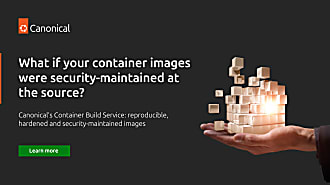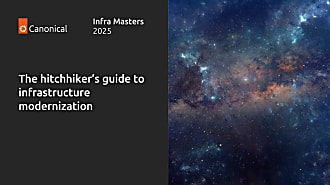Valentin Viennot
on 9 January 2023
Last August, we announced 6 MB-size Ubuntu base images designed for self-contained .NET applications — we called them “chiselled Ubuntu”. How did we make our Ubuntu base images 15 times smaller? And how can you create your own chiselled Ubuntu images?
In this blog, I explain the idea behind Distroless container images, which inspired us to create chiselled Ubuntu images — adding the “distro” back to distro-less! In a follow-up blog, I will then provide a step-by-step example of how you can create your own chiselled Ubuntu base container images, built for your specific needs.

Introduction to Distroless container images
Thanks to the widespread use of container images, developers now have an easy way to package an application and its dependencies into a self-contained unit compatible with any platform supporting the “OCI” standard (for example, Docker, Kubernetes or one of The 17 Ways to Run Containers on AWS). Container images make it easy to package and run applications in a consistent environment without worrying about differences in the host operating system or runtime environment.
Distroless container images are ultra-small images that only include an application and its runtime dependencies without additional libraries or utilities from a Linux distribution. This makes them smaller and more secure than traditional container images, which often include many libraries and utilities that are not needed by the application. In particular, traditional images often have a package manager and shell that give them their “look and feel”. In opposition, we could call them “distro-full”.
Minimal and mighty: the benefits of Distroless container images
Smaller container images have a de facto smaller attack surface, decreasing the likelihood of including unpatched security vulnerabilities and removing opportunities for attackers to exploit. But this probabilistic approach needs to consider how well-maintained the remaining content is. A large image with no CVEs and regular security updates is safer than an ultra-small unstable unmaintained one.
The ultimate security of a containerised application depends on various factors, including how it is designed and deployed and how it is maintained and updated over time. Using a well-maintained and supported Linux distribution like Ubuntu can help improve the security of containerised applications.
Additionally, smaller container images can save time and resources, especially in environments with limited storage capacity or where many container images are being used.
The best of both worlds: introducing Chiselled Ubuntu container images
Chiselled Ubuntu is a variation of Distroless container images built using the packages from the Ubuntu distribution. Chiselled Ubuntu images are carefully crafted to only fit the minimum required dependencies. They are constructed using a developer-friendly package manager called “Chisel”, which is only used at build time and not shipped in the final image. This makes them smaller and more secure than traditional Ubuntu container images, which often include many additional libraries and utilities.
Chiselled Ubuntu images inherit the advantages of the Ubuntu distribution: regularly updated and supported, offering a reliable and secure platform for creating and operating applications. On the other hand, they suppress the downsides of using a “distro-full” image when shipping to production.
“Breaking the Chisel” – how Chisel works
Chisel uses an open database of package slices, which supersedes the Debian packages database with specific file subsets and edited maintainer scripts for creating ultra-small runtime file systems. Chisel is a sort of “from-scratch package manager” that creates partial filesystems that just work for the intended use cases. The information contained in a Package slice is what image developers used to define manually at the image definition level when crafting Distroless-type images. With Chisel, community developers can now easily reuse this knowledge – effortlessly.

Chiselled Ubuntu container images are a new development that offers many benefits, including a consistent and compatible developer experience. They are slices of the same libraries and utilities in the regular Ubuntu distribution, making it easy to go from using Ubuntu in development to using chiselled Ubuntu in production. As a result, multi-stage builds work seamlessly with chiselled Ubuntu images.
Next steps: creating your own chiselled Ubuntu base container images
In conclusion, chiselled Ubuntu container images combine the benefits of Distroless containers with those of Ubuntu to create smaller, more secure containers that are easier to use. In this blog, I have explained the idea behind Distroless containers and introduced the concept of chiselled Ubuntu images. In the next blog, I will provide a step-by-step guide for creating chiselled Ubuntu base container images built for your specific needs. Ready? Keep reading!
- Part 2: Tutorial to build your own chiselled Ubuntu base
- Chisel in GitHub:https://github.com/canonical/chisel
- Open Source Summit Europe 2022 presentation on Chiselled Ubuntu
- Chiselled Ubuntu for .NET announcement
- Microsoft .NET developers’ 2022 conf x Chiselled Ubuntu keynote




